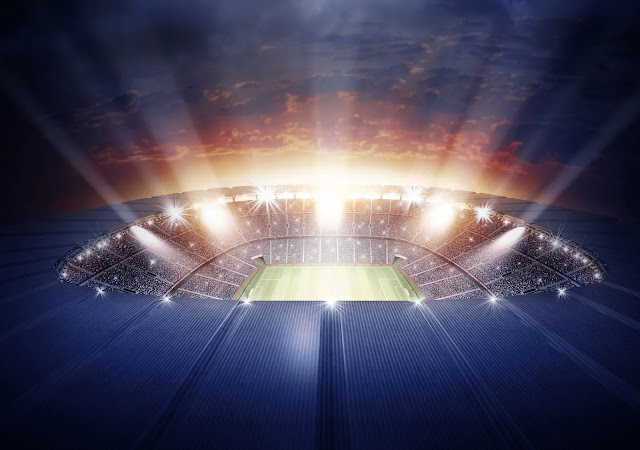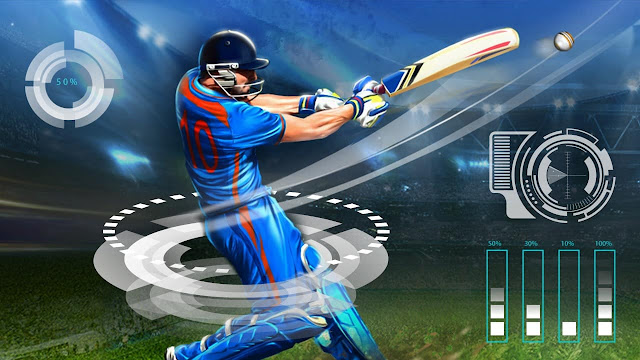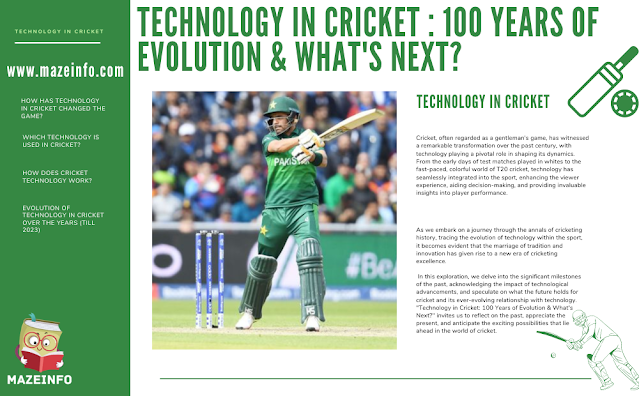Cricket, often regarded as a gentleman’s game, has witnessed a remarkable transformation over the past century, with technology playing a pivotal role in shaping its dynamics. From the early days of test matches played in whites to the fast-paced, colorful world of T20 world cup schedule cricket, technology used in cricket has seamlessly integrated into the sport, enhancing the viewer experience, aiding decision-making, and providing invaluable insights into player performance.
As we embark on a journey through the annals of cricketing history, tracing the evolution of technology within the sport, it becomes evident that the marriage of tradition and innovation has given rise to a new era of cricketing excellence. In this exploration, we delve into the significant milestones of the past, acknowledging the impact of technological advancements, and speculate on what the future holds for cricket and its ever-evolving relationship with technology. “Technology in Cricket: 100 Years of Evolution & What’s Next?” invites us to reflect on the past, appreciate the present, and anticipate the exciting possibilities that lie ahead in the world of cricket.
Early Technological Interventions in Cricket
Cricket, like many other sports, has seen significant drs technologies in cricket interventions over the years. These interventions aim to enhance the accuracy of decision-making, provide more information to players and coaches, and offer an enhanced viewing experience for fans. Here are some early technological interventions in cricket:
Hawk-Eye: Hawk-Eye technology is perhaps one of the most well-known innovations in cricket game. It uses multiple cameras to track the path of the ball and predict its future trajectory. Hawk-Eye is commonly used in Decision Review System (DRS) to assist umpires in making more accurate decisions regarding LBW (leg before wicket) appeals, edges, and ball tracking.
Snickometer: The Snickometer, or “Snicko,” is a tool that combines audio and visual technology used in cricket to detect whether the ball has made contact with the bat. It is often used as a part of the DRS to determine if there was an edge when a catch or an LBW decision is under review.
Ultra Edge: Ultra Edge is another technology integrated into the DRS. It uses real-time ball-tracking and audio technology to detect whether the ball has touched the bat or pad. Ultra Edge is often used in conjunction with other technologies to provide a more comprehensive analysis.
Hot Spot: Hot Spot is an infrared imaging system that helps in identifying contact between the ball and the mrf bat or pads. It is particularly useful in determining faint edges and has become a key component of the DRS, especially in cases where there is insufficient evidence from other technologies.
Spidercam: Spidercam is a camera system suspended on cables above the playing area. It provides dynamic and aerial views of the game, offering unique perspectives for viewers. While not directly influencing on-field decisions, Spidercam enhances the television broadcast experience.
LED Bails: Traditional bails have been replaced with LED bails that light up when the stumps are disturbed. This helps in quick and clear visibility for run-out and stumping decisions, especially in low light conditions.
Smart Stumps: Smartcric live Stumps are equipped with sensors and cameras to provide data on player movements, such as front foot no-balls. This technology is used to assist match officials in monitoring overstepping by bowlers.
Player Tracking Systems: GPS and motion-tracking technologies are used to monitor player movements and workload during matches and training sessions. This helps teams in managing player fitness and performance.
Revolution of Decision Review System (DRS)
.jpg)
The advent of the Decision Review System (DRS) has marked a revolutionary shift in the landscape of cricket in oregon, enhancing the accuracy and fairness of umpiring decisions. Introduced to address the occasional human errors that can influence the outcome of a match, the DRS employs cutting-edge technology, including ball-tracking and ultra-edge systems, to provide teams with the opportunity to challenge on-field decisions. This innovation has not only added a layer of transparency to the game but has also significantly reduced contentious moments on the field.
Players now have the means to contest decisions that may have been influenced by factors such as ball trajectory and impact with the bat or pad. The DRS has become an integral part of international psl live cricket, fostering a fairer and more accountable adjudication process while also adding an element of strategic decision-making for teams. Its successful implementation represents a positive step toward harnessing technology to uphold the integrity and spirit of the game.
Impact of Hawk-Eye and Ball Tracking Technology
Hawk-Eye and ball by ball tracking technology have had a significant impact on various sports, particularly in cricket and tennis. These technologies use cameras and sophisticated computer algorithms to track the trajectory of the ball with high precision. Here are some of the key impacts:
Accurate Decision Making
In cricket, Hawk-Eye technology in cricket is often used for Decision Review System (DRS), allowing players to challenge on-field umpire decisions. It provides a more accurate representation of the ball’s path, helping in making fair and precise decisions regarding dismissals, lbw (leg before wicket) calls, and more.
In tennis, ball tracking technology assists in line-calling, reducing human error and ensuring fair play. Players can challenge calls, and the system provides an accurate replay of the ball’s impact.
Improved Spectator Experience
Hawk-Eye and ball tracking technolog in cricket enhance the viewing experience for spectators. Fans can see replays and visualizations of the ball’s movement in real-time, adding an extra layer of excitement and engagement to the game.
Player Analysis and Performance Improvement
Coaches and players benefit from the detailed data provided by these technologies. They can analyze the trajectory, speed, and movement of the ball, helping players identify strengths and weaknesses. This information is crucial for strategizing and improving performance.
Fairness and Integrity
The use of technology in cricket ppt contributes to the fairness and integrity of sports. It reduces controversies related to umpire or referee decisions and promotes a sense of transparency in the game.
Strategic Decision-Making
Teams and players can use the data generated by Hawk-Eye and ball tracking for strategic planning. Understanding the patterns and tendencies of opponents can influence play cricket game strategies and tactics.
Challenges and Debates
The introduction of technology in sports officiating has sparked debates about its role and impact. Some argue that it enhances the integrity of the game, while others worry about the potential for over-reliance on technology and the impact on the human element of officiating.
Expanded Use in Other Sports
Beyond cricket and tennis, similar tracking technolog in cricket bats are being explored and implemented in other sports. For example, goal-line technology in soccer determines whether a ball has crossed the goal line, helping officials make accurate decisions.
Continuous Technological Advancements
Hawk-Eye and ball tracking technologies continue to evolve with advancements in camera technology, artificial intelligence, and data analytics. This ongoing development contributes to even greater accuracy and reliability in sports officiating.
Also, Read More: How to Easily Host a Barbie Birthday Party
The Rise of Wearable Technology in Player Performance Analysis

The rise of wearable technology has revolutionized player performance analysis in the world of sports. Athletes and coaches now have access to a wealth of data that goes beyond traditional performance metrics, providing a comprehensive understanding of an individual’s physical and physiological characteristics. Wearable devices, such as smartwatches, fitness trackers, and specialized circket ipl sensors, enable real-time monitoring of key parameters like heart rate, body temperature, and movement patterns. This wealth of information is invaluable for assessing an athlete’s overall health, identifying areas for improvement, and tailoring training programs to specific needs.
Additionally, wearable hotspot technology in cricket has enhanced the precision of performance analytics, allowing for more informed decision-making during training sessions and competitions. The integration of these devices into sports has not only elevated the level of individualized training but has also contributed to a more data-driven and strategic approach to player development and game strategy. As the technology continues to evolve, its impact on player performance analysis is likely to grow, offering unprecedented insights that can shape the future of sports training and competition.
Data Analytics and its Influence on Strategy
Data analytics plays a crucial role in shaping and influencing business strategy across various industries. Here are some ways in which data analytics impacts and influences strategic decision-making:
| Aspect | Description |
| Decision Making | Informed, data-driven decisions for strategic planning. |
| Competitive Advantage | Gain edge by analyzing market trends and competitors. |
| Customer Insights | Understand behavior for tailored products and services. |
| Risk Management | Proactively identify and mitigate potential risks. |
| Operational Efficiency | Improve efficiency through process analysis. |
| Innovation | Foster innovation by identifying market opportunities. |
| Cost Optimization | Identify cost-saving opportunities for efficiency. |
| Personalization | Tailor marketing and customer experiences. |
| Agile Strategy Development | Quickly adapt strategies to changing conditions. |
| Regulatory Compliance | Ensure compliance and address regulatory challenges. |
| Long-Term Planning | Use historical data for realistic, sustainable growth. |
Real-time Player Monitoring and Fitness Technology

Real-time player monitoring and fitness technology have become integral aspects of modern my cricket, providing teams and players with valuable data to enhance performance, prevent injuries, and optimize training. Several technologies are employed to monitor players in real-time and improve their fitness levels:
Player Performance Metrics
Real-time player monitoring technology in cricket focuses on collecting and analyzing key performance metrics. This includes data such as heart rate, speed, distance covered, and player workload during training sessions and matches. By continuously tracking these metrics, coaches and support staff can assess a player’s physical condition, fatigue levels, and overall performance. This data-driven approach enables targeted training programs and helps in making informed decisions regarding player rotation, workload management, and injury prevention.
Biomechanical Analysis
Another crucial aspect of real-time monitoring in cricket is biomechanical analysis. High-tech sensors and cameras are used to capture and analyze a player’s movements, including their batting and bowling techniques. This ultra edge technology in cricket provides detailed insights into the biomechanics of a player’s actions, helping coaches refine techniques, correct any flaws, and optimize performance. Biomechanical data can also be used to identify potential injury risks and design personalized rehabilitation programs.
Recovery Management
Real-time monitoring extends beyond the field, encompassing player recovery management. New technolog in cricket such as wearables and sleep tracking devices help monitor players’ sleep patterns, stress levels, and overall well-being. This information is vital for optimizing recovery strategies, ensuring that players are adequately rested and prepared for upcoming matches. By understanding each player’s recovery needs, teams can implement personalized recovery plans, including proper nutrition, hydration, and rest, to enhance overall player fitness and reduce the risk of injuries.
Introduction of Smart Stadiums and Fan Engagement

Smart stadiums and fan engagement in cricket live have evolved significantly in recent years, transforming the traditional spectator experience into a technologically advanced and interactive affair. These innovations aim to enhance the overall enjoyment for fans while providing new opportunities for teams, sponsors, and organizers. Let’s delve into the introduction of smart stadiums and fan engagement in the context of cricket.
Smart Stadiums
Technological Integration: Smart stadiums leverage cutting-edge technologies such as Internet of Things (IoT), sensors, and connectivity to enhance various aspects of the game-day experience.
Connectivity and Wi-Fi: Robust Wi-Fi infrastructure ensures that fans can stay connected throughout the game, enabling them to share their experiences on social media, access real-time statistics, and engage with interactive content.
Mobile Apps: Dedicated mobile applications allow fans to access a wide range of features, willow cricket including virtual seat upgrades, in-seat food and beverage ordering, and personalized content based on their preferences.
Augmented Reality (AR) and Virtual Reality (VR): Smart stadiums incorporate AR and VR technologies to provide immersive experiences, such as augmented overlays of player statistics, instant replays, or virtual tours of the stadium.
Digital Signage: Dynamic digital displays and signage within the stadium keep fans informed about live scores, player stats, and promotional content. This enhances the visual appeal of the stadium and contributes to a more engaging atmosphere.
Fan Engagement in Cricket
Social Media Interaction: Cricket teams and leagues actively engage with fans on social media platforms, sharing behind-the-scenes content, live cricket match today, live updates, and encouraging fans to participate in discussions through hashtags and interactive posts.
Fantasy Cricket: Fantasy cricket bat platforms allow fans to create their own virtual teams, earn points based on player performances, and compete with friends and other fans. This adds an extra layer of excitement to the game.
Interactive Contests and Polls: Teams and sponsors organize online contests, polls, and quizzes to keep fans engaged. Predicting match outcomes, voting for player of the match, and participating in interactive challenges are popular fan activities.
Virtual Meet-and-Greets: Using video conferencing technology, live cricket streaming teams arrange virtual meet-and-greet sessions with players, providing fans with a unique opportunity to interact with their favorite stars.
Augmented Reality (AR) Experiences: AR features in mobile apps allow fans to overlay interactive elements on their physical surroundings. This could include player holograms, interactive games, or exclusive content triggered by scanning logos or images.
Emerging Technologies: AI, Virtual Reality, and the Future of Cricket

The intersection of emerging technologies like Artificial Intelligence (AI), Virtual Reality (VR), and traditional sports like cricket holds the potential to revolutionize the game in various ways. Here are some possibilities and developments in this regard:
AI-Powered Analytics in Cricket
The integration of artificial intelligence (AI) in smartcric is revolutionizing the game through advanced analytics. AI algorithms analyze vast amounts of data, including player performance statistics, match conditions, and historical trends, providing teams with valuable insights. Coaches can make data-driven decisions, optimize strategies, and enhance player performance, ultimately influencing the outcome of matches.
Virtual Reality (VR) Training for Cricketers
Virtual Reality is increasingly being employed in cricket live score for player training and skill development. VR simulations allow cricketers to experience realistic game scenarios, helping them improve decision-making, reflexes, and overall game awareness. Batsmen can face simulated deliveries, bowlers can practice against virtual batsmen, and fielders can enhance their reaction times—all contributing to more effective and immersive training experiences.
Fan Engagement through Augmented Reality (AR)
Augmented Reality is transforming the way cricket world cup fans engage with the sport. AR applications provide fans with interactive and immersive experiences during matches, such as live statistics overlays, player insights, and 3D replays. This technology enhances the viewing experience, making it more captivating and informative. Additionally, AR is used in stadium experiences, offering fans on-site interactive elements like virtual player holograms or augmented reality games, further connecting them to the excitement of the game.
Conclusion
The evolution of technology in cricket over the past century has been transformative, enhancing the game in ways unimaginable in its early years. From basic innovations like protective gear to the advent of Decision Review System (DRS) and Hawk-Eye technology, watch live cricket has embraced advancements that have improved fairness, accuracy, and entertainment.
Looking ahead, the future promises even more exciting developments, with the potential integration of artificial intelligence, advanced analytics, and virtual reality. These advancements will not only benefit players and officials but also enrich the fan experience, making cricket a more immersive and dynamic sport. As technology continues to push boundaries, the next chapter in cricket’s evolution holds the promise of further innovation, ensuring the game remains at the forefront of modern sports entertainment.
Frequently Asked Questions
Q: How has technology impacted cricket in the last 100 years?
Ans: Technology has transformed cricket with innovations like Hawk-Eye, UltraEdge, and ball-tracking systems. These tools enhance decision-making accuracy, providing players and umpires with valuable insights.
Q: What role do Decision Review System (DRS) and ball-tracking technologies play in modern cricket?
Ans: DRS allows teams to challenge on-field decisions, and ball-tracking provides a detailed analysis of ball trajectory. This technology has significantly reduced umpiring errors and added a layer of fairness to the game.
Q: How has the use of wearable technology affected player performance and training?
Ans: Wearable devices like fitness trackers and smartwatches monitor players’ health, fitness levels, and performance metrics. This data helps in optimizing training regimes, injury prevention, and enhancing overall player well-being.
Q: What is the impact of video analysis on player strategy and team performance?
Ans: Video analysis tools enable coaches and players to study opponents’ strengths and weaknesses, analyze match footage, and strategize more effectively. This technology has become an integral part of pre-match preparation and post-match review.
Q: How has the introduction of 5G technology enhanced the viewer experience in cricket?
Ans: 5G technology has improved live streaming, providing high-quality, low-latency broadcasts. This enhances the viewer experience by allowing fans to watch matches in real-time with excellent clarity, contributing to the global reach of the sport.
Q: What emerging technologies are likely to shape the future of cricket in the next decade?
Ans: Artificial Intelligence (AI), Virtual Reality (VR), and Augmented Reality (AR) are anticipated to play a significant role in cricket’s future. These technologies could impact player training, fan engagement, and the overall immersive experience of the game.



